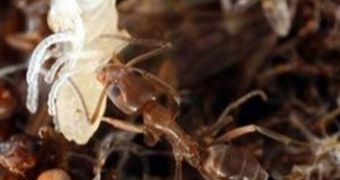Argentine ants are a very curious species, on account of the fact that they are among the few animals in the world that have a “morgue,” and workers dealing specifically with carrying away the bodies of the dead. But the workers are pretty much blind, and they must rely on their senses to identify their next targets. And that's why pupae, or larvae, and pretty much everything that's still alive and kicking, is sprayed with two chemical substances that researchers studying the insects have colorfully termed the “stench of life.” This means that, when they feel these chemicals, the workers move away, and do not carry the “victim” away.
The two dolichodial and iridomyrmecin chemicals are produced by the ants themselves while they are alive. However, the production stops within minutes after their death, so the workers know it's time to carry them away. Though it may seem a bit cruel, this raw garbage-disposal mechanism ensures that no carcasses become infected with pathogens, or with harmful chemicals that could potentially wipe out a good part, if not all, of the colony. The swiftness of action is key here, and workers will relentlessly carry anything away that is not producing the chemicals.
Behind the new research was University of California Entomologist Dong-Hwan Choe, who proved that the long-held idea that the build-up of fats after death was the main trigger for worker ants to get rid of the carcasses, first set forth by ant expert E. O. Wilson, was false.
The new study also clears the mystery of why some species of ants and bees get rid of their dead even before the fat in the dead bodies reaches high concentration levels. Choe's team also determined that fats, indeed, played a role, but not one as important as first thought. When they coated larvae with fats extracted from live ants, workers carried them to the morgue within ten minutes.
This implies, the researchers say, that dolichodial and iridomyrmecin act as “overrides” for the natural tendency that workers have, of carrying bodies away from the main colony. Also, when the experts placed the two chemicals on pupae, which don't naturally produce them, workers ignored them, and didn't carry them away.
“This is an exciting result that helps to dispel a widespread myth that persisted despite the lack of evidence. It seems to me very possible that there are similar chemical changes in other social insects and I hope this work inspires people to look,” Stanford University Entomologist Deborah Gordon told New Scientist.

 14 DAY TRIAL //
14 DAY TRIAL //